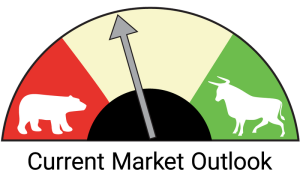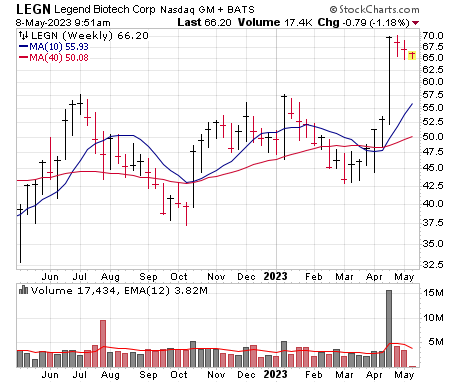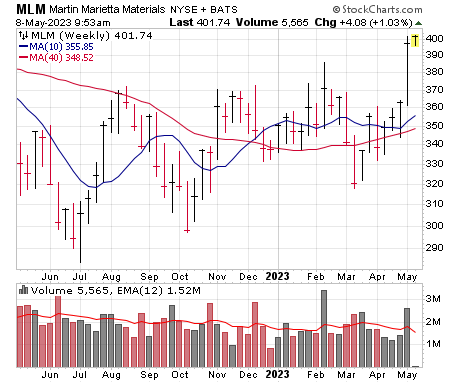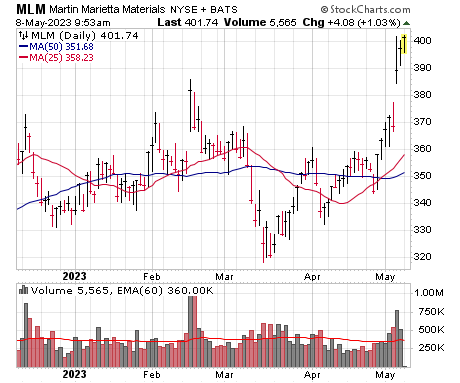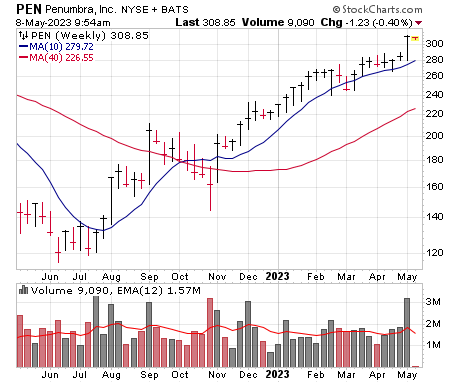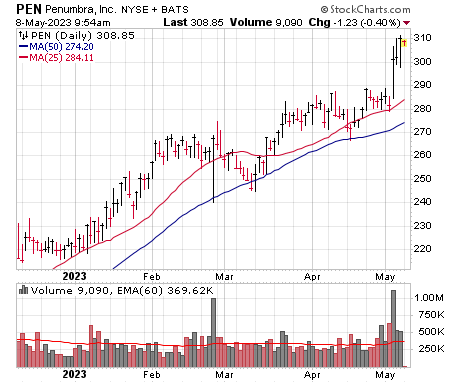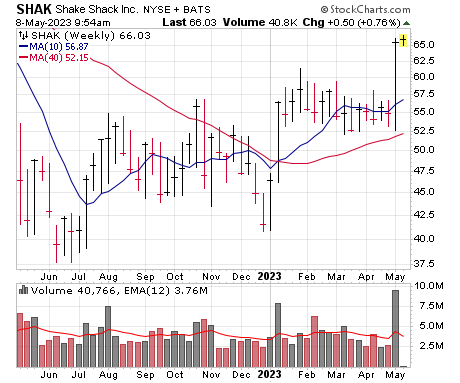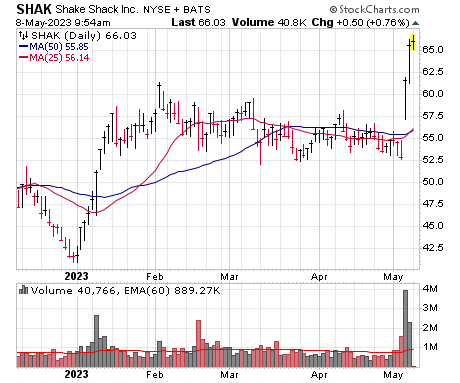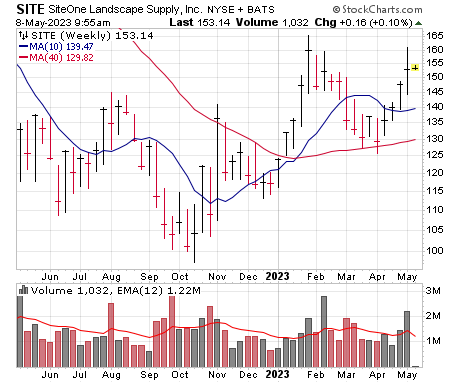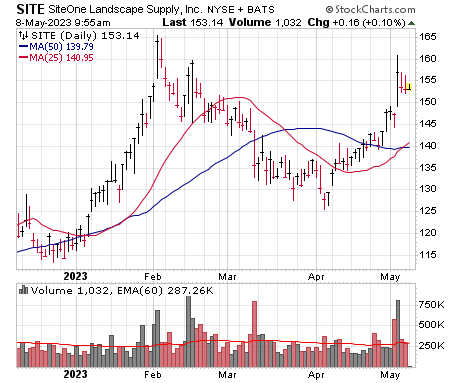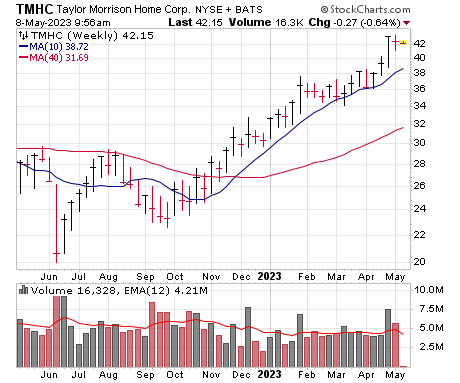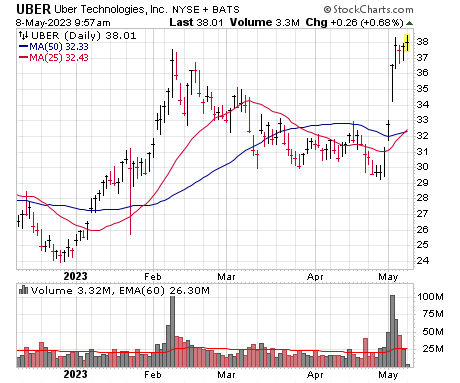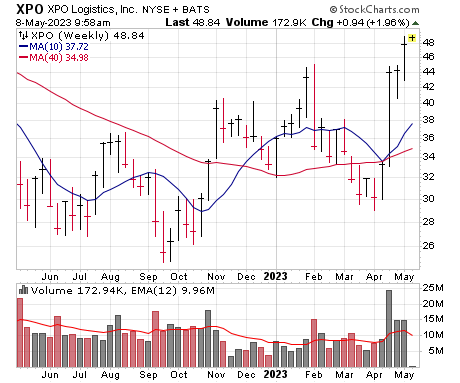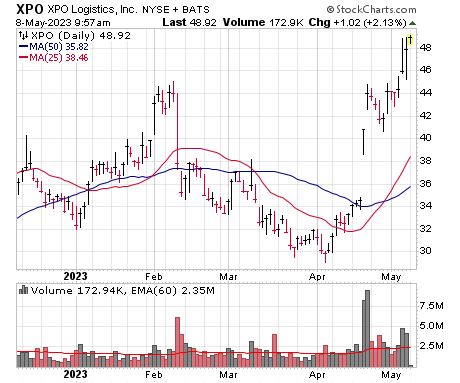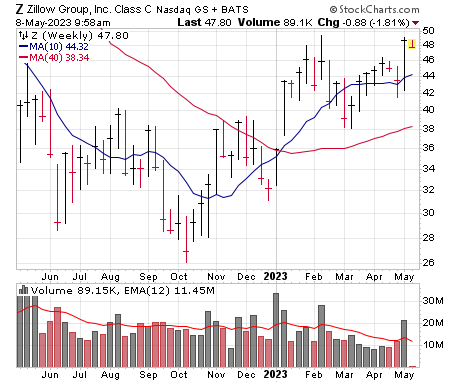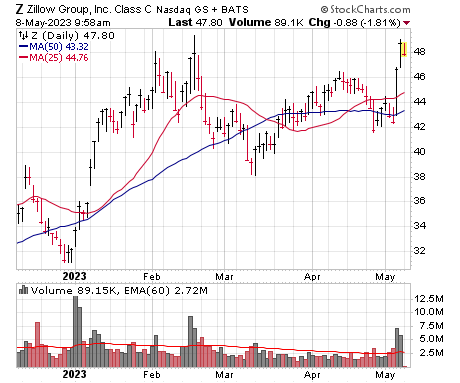Story Remains the Same
We don’t want to fire up our computer and write the same thing week after week, but the fact is the story remains mostly the same as it has for the past two months: There are definitely some positives out there, including a good number of setups, some positive earnings reactions (last week anyway) and a resilient set of major indexes, especially given the banking worries—but the broad market is mostly iffy while we continue to see repeated air pockets and selling on strength, which is not the hallmark of a sustained rally. We’re not overly negative here, and still think there’s lots of bullish dry tinder that could spark if things go right, but until it happens, we think it’s best to remain cautious, keep positions small—and keep your eyes open for signs of any character change. We’ll leave our Market Monitor at a level 4.
This week’s list sports more than a few recent earnings winners, as well as a few tight setups. Our Top Pick is Shake Shack (SHAK), which has a spotty history but appears to be getting costs under control—combined with its cookie-cutter story, that could produce reliable bottom-line growth soon. Try to buy on dips.
| Legend Biotech (LEGN) |
| Martin Marietta (MLM) |
| Penumbra (PEN) |
| Shake Shack (SHAK) ★ Top Pick ★ |
| SiteOne Landscape (SITE) |
| Spotify (SPOT) |
| Taylor Morrison Home (TMHC) |
| Uber (UBER) |
| XPO Logistics (XPO) |
| Zillow (Z) |
Stock 1
Legend Biotech (LEGN)
Price | Buy Range | Loss Limit |
Why the Strength
An unnamed institutional investor bought 7.66 million shares of Legend Biotech, about 2.5% of the company, in a private placement at the equivalent of $52.24 per ADS, signaling faith in the recent emergence of Legend from a developmental drugmaker to a commercial one. Legend’s first commercial product hit the market last year—dubbed Carvykti, it’s a treatment for adults with relapsed or refractory multiple myeloma who previously received a proteasome inhibitor, an immunomodulatory agent and an anti-CD38 antibody. The treatment is approved in the U.S., Europe and Japan and it’s likely to move forward in China as well. Hong Kong-domiciled and headquartered in New Jersey, Legend generated $48.2 million of 2022 Carvykti revenue under a production and distribution agreement with Johnson & Johnson’s Janssen division, which is obviously a powerful backer. Legend as a whole generated revenue of $117 million last year thanks to licensing and collaboration agreements, though the bottom line was deeply in the red. Wall Street expects revenue to double this year to $234 million as Carvykti has a full year of sales in its markets, and with $1 billion of cash on hand (more after today’s private placement), there are plenty of funds to get the firm well into 2025. The stock’s recent strength, though, stems from the pipeline: A recently concluded successful Phase III trial to extend Carvykti to additional types of myeloma patients was released (risk of relapse was 74% less compared to standard treatment, which is far better than the 51% decline from a competing drug from Squibb), and it’s a potentially large market, since multiple myeloma is the third most common blood cancer, with more than 100,000 incidents last year in the U.S., E.U. and China. The business also has another 17 therapies in various stages of clinical trials, including three in Phase III in partnership with Janssen.
Technical Analysis
LEGN has been up and down during the past 18 months, but what’s interesting is there’s been some tightening along the way—and the latest upmove looks like a real breakout. The stock fell to nearly 30 in March 2022, but that was the low, with higher lows in October last year (near 37) and again in March (43), with shares testing the upper 50s many times in between those bottoms. The move three weeks ago was on massive volume, and the tight rest the past two weeks is a good sign. We prefer targeting a retreat of a couple of points if you want in.
| Market Cap | $11.1B | EPS $ Annual (Dec) | ||
| Forward P/E | N/A | FY 2021 | -2.71 | |
| Current P/E | N/A | FY 2022 | -2.80 | |
| Annual Revenue | $117M | FY 2023e | -1.48 | |
| Profit Margin | N/A | FY 2024e | -1.66 | |
| Qtrly Rev | Qtrly Rev Growth | Qtrly EPS | Qtrly EPS Growth | |
| ($M) | (vs. yr-ago-qtr) | ($) | (vs. yr-ago-qtr) | |
| Latest qtr | 25.4 | -35% | -0.78 | N/A |
| One qtr ago | 25.4 | 50% | -0.78 | N/A |
| Two qtrs ago | 25.4 | 26% | -0.78 | N/A |
| Three qtrs ago | 40.8 | 198% | -0.50 | N/A |
Weekly Chart | Daily Chart |
Stock 2
Martin Marietta (MLM)
Price | Buy Range | Loss Limit |
Why the Strength
Martin Marietta is one of the most direct plays on building, construction and infrastructure work—it’s one of two big players in the construction aggregates field, which is the crushed stone, gravel, slag, sand and even cement and ready-mix concrete that’s needed in just about any sort of building project. You’d think it would be a relatively cyclical industry, but prices for these products tend to advance very steadily (it was able to pass along higher costs in the past year), and Martin Marietta’s nationwide footprint means it’s not overly exposed to one area or type of construction project. Right now, the backdrop is mostly bullish, with infrastructure and non-residential demand fairly strong and with so many state and federal programs (green energy, chips act, infrastructure) having been passed, the firm sees years of solid demand ahead. The stock is strong today because Q1 results were good and business should pick up down the road: Aggregates shipments were actually down 1% (the wet weather in California was a big reason for that), but prices were up a whopping 23%, leading to a surge in gross profit and margins. Indeed, EBITDA was up 64% on a 10% revenue hike, with EBITDA margins surging 7.9 percentage points from the year before. Long story short, the price hikes of last year should keep cash flow strong for the rest of this year, and as government projects begin (and possibly as the residential housing market rebound), demand should accelerate in 2024 and beyond.
Technical Analysis
MLM isn’t a go-go stock, but it’s been able to trend in the past, with a solid upmove into late 2021 and, of course, a sharp pullback (~35%) last year. The absolute bottom was seen in July near 285, with higher lows seen in October (298) and March of this year (318)—and now the buyers are actually showing up, with last week’s quarterly report driving MLM to 12-month highs. We’re OK picking up a few shares here or (preferably) on dips.
| Market Cap | $24.7B | EPS $ Annual (Dec) | ||
| Forward P/E | 25 | FY 2021 | 12.29 | |
| Current P/E | 28 | FY 2022 | 12.07 | |
| Annual Revenue | $6.28B | FY 2023e | 15.95 | |
| Profit Margin | 9.9% | FY 2024e | 18.26 | |
| Qtrly Rev | Qtrly Rev Growth | Qtrly EPS | Qtrly EPS Growth | |
| ($B) | (vs. yr-ago-qtr) | ($) | (vs. yr-ago-qtr) | |
| Latest qtr | 1.35 | 10% | 2.16 | 427% |
| One qtr ago | 1.48 | -1% | 3.04 | -3% |
| Two qtrs ago | 1.81 | 16% | 4.69 | 10% |
| Three qtrs ago | 1.64 | 19% | 3.96 | 4% |
Weekly Chart | Daily Chart |
Stock 3
Penumbra (PEN)
Price | Buy Range | Loss Limit |
Why the Strength
Nearly 100 million people per year suffer a stroke, a condition often caused by a thrombosis, or blood clot, that develops in an artery. Medical device maker Penumbra (covered in the March 20 report) is focused on therapies that address strokes, heart attacks and other diseases that restrict blood flow, including its Indigo Aspiration System (IAS)—a minimally-invasive device used to remove blood clots from vessels of the peripheral arterial and venous systems, as well as for the treatment of pulmonary embolisms. The stock’s latest show of strength is courtesy of stellar earnings last week which saw Penumbra deliver quarterly revenue of $241 million that improved 18% from a year ago. Moreover, Q1 revenue increased $20 million from the prior quarter, which represents the fastest sequential dollar growth in the company’s history, while per-share earnings of 23 cents crushed estimates by 12 cents. The solid results were led by sales of vascular products that grew 16% from a year ago, as well as by neuro product sales growth of 22%. Another highlight of the quarter was the launch of Penumbra’s Lightning Flash mechanical thrombectomy system, which the firm said was its biggest product launch ever and exceeded its sales expectations while driving the acceleration of its U.S. vascular business (up 23% in Q1) and its U.S. vascular thrombectomy franchise (up 26%). Penumbra is following this up with the recent launch of the Lightning Bolt 7, designed for single-session arterial thrombus removal that, along with many other recent launches, has added “significant momentum” to its ischemic stroke business. Management is optimistic going forward and raised 2023 revenue guidance, with analysts seeing nearly a 25% top-line gain while the bottom line is just starting what should be a multi-quarter boom.
Technical Analysis
PEN isn’t in the first inning of its overall advance, so there’s risk the sellers may show up given the market’s on-again, off-again environment. But there’s no doubt the buyers remain in control right now—after hitting a higher low last October, shares began what’s been a relatively persistent advance, with occasional tests of the 50-day line finding support. As with many stocks, we like PEN’s recent tight trading and the post-earnings move to new highs. If you want in, we’re fine grabbing a few shares here or on dips.
| Market Cap | $11.8B | EPS $ Annual (Dec) | ||
| Forward P/E | 201 | FY 2021 | 0.70 | |
| Current P/E | 736 | FY 2022 | 0.16 | |
| Annual Revenue | $884M | FY 2023e | 1.54 | |
| Profit Margin | 3.7% | FY 2024e | 2.50 | |
| Qtrly Rev | Qtrly Rev Growth | Qtrly EPS | Qtrly EPS Growth | |
| ($M) | (vs. yr-ago-qtr) | ($) | (vs. yr-ago-qtr) | |
| Latest qtr | 241 | 18% | 0.23 | N/A |
| One qtr ago | 221 | 8% | 0.16 | 60% |
| Two qtrs ago | 214 | 12% | 0.01 | -92% |
| Three qtrs ago | 208 | 13% | 0.01 | -95% |
Weekly Chart | Daily Chart |
Stock 4
Shake Shack (SHAK) ★ Top Pick ★
Price | Buy Range | Loss Limit |
Why the Strength
Shake Shack is basically an international roadside burger stand, with 456 locations around the world serving very tasty burgers, chicken sandwiches and nuggets, sausages, fries and dogs, along with shakes, lemonade and the like. As we’ll see later in this issue, this company’s overall story has a similar theme to Uber: Demand has never been a problem, with management rapidly increasing the restaurant base from its New York City roots, spreading across the U.S. and making a push overseas, with both company-owned and licensed locations; sales have been kiting higher for years and the restaurant count at the end of March was up 13 from the prior quarter and up a whopping 17% from a year ago. However, all that growth was offset by huge costs, which mostly kept the bottom line in check (and, except for the occasional run of a few months, capped the stock, too). Now, though, one of management’s priorities is to increase margins, and progress is happening—in Q1, food and paper costs as a percent of revenue fell a full percentage point (to 29.4%), while labor expenses and G&A also came down, leading to store-level profit margins of 18.3%, up from 15.2% last year ... and the top brass sees this figure getting back over 20% (it was even higher in the past) as soon as this quarter! Meanwhile, the expansion plan remains in fifth gear (20 new openings planned in Q2 alone, both company-owned and licensed) and demand is strong (same-store sales up more than 10% in Q1), which has Wall Street goosing estimates—EBITDA is solidly in the black, and analysts now see the bottom line following in the near future. There are still some holes in the story (new location economics are just OK), but if the top brass can keep a lid on costs, there’s no reason earnings can’t surprise on the upside for many quarters.
Technical Analysis
SHAK cratered from 140 in early 2021 to below 40 in June of last year as inflation crimped what was already an iffy cost situation. And from there, the stock didn’t really stand out, with a modest summer rally, a retest of the low at year-end and a January 2023 upmove that only lasted a couple of weeks. However, SHAK’s action from there was notable, with lots of tightness and volume really drying up, and last week’s earnings move (biggest weekly volume since November 2021) was powerful. We’ll set our buy range down a bit, thinking a wobble is likely.
| Market Cap | $2.80B | EPS $ Annual (Dec) | ||
| Forward P/E | N/M | FY 2021 | -0.06 | |
| Current P/E | N/A | FY 2022 | -0.33 | |
| Annual Revenue | $951M | FY 2023e | 0.11 | |
| Profit Margin | N/A | FY 2024e | 0.21 | |
| Qtrly Rev | Qtrly Rev Growth | Qtrly EPS | Qtrly EPS Growth | |
| ($M) | (vs. yr-ago-qtr) | ($) | (vs. yr-ago-qtr) | |
| Latest qtr | 253 | 25% | -0.01 | N/A |
| One qtr ago | 239 | 17% | -0.06 | N/A |
| Two qtrs ago | 228 | 17% | -0.06 | N/A |
| Three qtrs ago | 231 | 23% | 0.01 | -80% |
Weekly Chart | Daily Chart |
Stock 5
SiteOne Landscape (SITE)
Price | Buy Range | Loss Limit |
Why the Strength
SiteOne Landscape is North America’s largest wholesale distributor of landscaping supplies, irrigation tools and agronomic maintenance, with more than 640 branches that sell to a customer base of nearly 300,000. Persistent inflation and rising home prices are putting a damper on the residential housing market, which accounts for about 20% of the company’s sales, and SiteOne expects this market to shrink by about that same amount this year. Yet that hasn’t dampened the firm’s growth plans—at heart, SiteOne has always been a roll-up play, as the industry is extremely fragmented (SiteOne is four times the size of its nearest competitor, but has just 16% market share) and the firm has plenty of capital to absorb smaller players. Thus, a down market should open up new acquisition opportunities on top of its already “robust” acquisition pipeline (the latest was the purchase of Whittlesey Landscape Supplies & Recycling, which SiteOne said establishes it as the leader in bulk landscape supplies and hardscapes in central Texas, one of the fastest growing markets in the U.S.). SiteOne also expects the commercial and recreational construction market to be stable this year; along with the remodeling market, they collectively account for around 44% of sales. In a quarter marked by stiffening economic headwinds, the company still managed to deliver margin expansion in a continuation of last year’s trends (a reason for the stock’s strength). Revenue of $837 million in Q1 increased 4% from a year ago, while per-share earnings of three cents beat estimates by eight cents. The top brass believes the company is still relatively early in its development as a “true world-class company” and said it’s off to a solid start for the year, adding that it feels good about the “resilient market demand and our outlook for 2023.” SiteOne guided for full-year adjusted EBITDA of around $410 million (down 11% from 2022), though that’s likely conservative, especially if M&A activity picks up.
Technical Analysis
SITE reached a long-term peak at 260 in November 2021 after the pandemic-led moonshot (which was marked by explosive demand for landscaping), then plunged to just under 100 by October of last year. Its fortunes changed after that, with a quick move to 140, and after a pullback, another thrust to 160. And now we see a calm, well-formed launching pad during the past three months. The recent pop on earnings was solid, but we think entering on a bit more weakness is your best bet.
| Market Cap | $6.89B | EPS $ Annual (Dec) | ||
| Forward P/E | 37 | FY 2021 | 5.20 | |
| Current P/E | 34 | FY 2022 | 5.36 | |
| Annual Revenue | $4.05B | FY 2023e | 4.13 | |
| Profit Margin | N/A | FY 2024e | 4.76 | |
| Qtrly Rev | Qtrly Rev Growth | Qtrly EPS | Qtrly EPS Growth | |
| ($M) | (vs. yr-ago-qtr) | ($) | (vs. yr-ago-qtr) | |
| Latest qtr | 837 | 4% | -0.10 | N/A |
| One qtr ago | 890 | 11% | -0.02 | N/A |
| Two qtrs ago | 1103 | 18% | 1.60 | -8% |
| Three qtrs ago | 1217 | 12% | 3.07 | 14% |
Weekly Chart | Daily Chart |
Stock 6
Spotify (SPOT)
Price | Buy Range | Loss Limit |
Why the Strength
Streaming music service provider Spotify (covered in the March 27 issue) blew everyone’s expectations away in the first quarter—including its own—by more than doubling its subscriber growth estimates from January. While the company had previously anticipated attracting 11 million new active monthly users in Q1, it ended up gaining an eye-popping 26 million—a 137% increase in new subs from last year—which set a quarterly record (its second consecutive one) for this vital metric, allowing Spotify to finish the quarter with 515 million monthly active users (MAUs, a leading indicator for future sales). While the firm missed top- and bottom-line estimates (a per-share earnings loss of $1.26 missed the consensus by 23 cents), premium subscription sales jumped 14% to $3 billion, while ad-supported revenue increased 17%. The results showed that Spotify’s strategy of expanding its exclusive podcast and audiobook offerings to attract new customers (and keep existing ones) is paying off, along with a recently launched “personal DJ” driven by artificial intelligence that customizes offerings tailored to the musical tastes of individual customers while providing them with interesting facts about each artist. Spotify expects additional growth in Q2 and expects to reach 530 million MAUs by June, while the firm said subscriber retention rates are also picking up. Wall Street was impressed by the figures, with a major bank raising its target and outlook for the firm (another reason for the strength). Analysts see Spotify’s strategies pushing the bottom line into the black by late next year as the top line lifts in the mid/upper teens.
Technical Analysis
SPOT reversed a downward trend immediately after the New Year, accelerating from a low at 70 last November and reaching nearly 130 in February (shortly after our initial coverage). What’s encouraging is that, while so many stocks gave back a good chunk of their early-year move, this one did not—SPOT held firm and generally rode its 50-day line higher in the weeks that followed, and while the post-earnings action was wobbly, shares are hitting new closing highs. We’re OK nibbling here with a stop near the 50-day line.
| Market Cap | $27.4B | EPS $ Annual (Dec) | ||
| Forward P/E | N/A | FY 2021 | -0.20 | |
| Current P/E | N/A | FY 2022 | -2.39 | |
| Annual Revenue | $12.7B | FY 2023e | -2.57 | |
| Profit Margin | N/A | FY 2024e | -0.03 | |
| Qtrly Rev | Qtrly Rev Growth | Qtrly EPS | Qtrly EPS Growth | |
| ($B) | (vs. yr-ago-qtr) | ($) | (vs. yr-ago-qtr) | |
| Latest qtr | 3.30 | 12% | -1.26 | N/A |
| One qtr ago | 3.39 | 11% | -1.50 | N/A |
| Two qtrs ago | 2.98 | 3% | -0.84 | N/A |
| Three qtrs ago | 3.00 | 9% | -0.68 | N/A |
Weekly Chart | Daily Chart |
Stock 7
Taylor Morrison Home (TMHC)
Price | Buy Range | Loss Limit |
Why the Strength
Taylor Morrison is one of the nation’s largest homebuilders and land developers, with a focus on providing first-time homes and residential construction for families. Although economic and interest rate uncertainty led to a modest revenue decline in Q1 (down 2%), the company managed to blow past earnings estimates as EPS of $1.74 surprised the consensus by 37 cents while increasing more than 20% from a year ago (accounting for the latest show of strength). The company’s efficiencies in the quarter also allowed it to improve operating margins (a major part of its strategy) and grow its book value 32%. Additionally, the minor drop in home closing sales was offset by a 7% increase in the average closing price, to $635,000, and more importantly, the company said sales momentum accelerated further into March following a strong start to the year (and despite the uncertainties facing the industry) as the cancellation rate declined to “more normalized levels” of 14% of gross orders. Leading indicators such as sales traffic, mortgage pre-qualifications and digital home reservations, meanwhile, remained the firm’s top conversion source in Q1 at a rate of 40%, which Taylor Morrison said points to continued strength. And it said approximately $2 billion in total liquidity, along with an all-time low net debt-to-capital ratio of 21%, leaves it in a position of “significant financial flexibility” for expanding its business and increasing shareholder returns going forward. Of course, the anticipation of a Fed pause (or rate cut cycle) and tamer mortgage rates is a big help, too. Earnings here should still slough off for a while longer, but the valuation tells us the slowdown has been priced in.
Technical Analysis
Along with most of its homebuilding peers, TMHC peaked in late 2021, hit a nadir in June and then a higher low in the fall—and since then, the buyers have been in control. Unlike many peers, TMHC held up very well during the market’s February/March wobbles, with the 50-day line offering support and with shares extending higher in April and early May. A modest retreat should be buyable.
| Market Cap | $6.34B | EPS $ Annual (Dec) | ||
| Forward P/E | 6 | FY 2021 | 5.18 | |
| Current P/E | 4 | FY 2022 | 9.27 | |
| Annual Revenue | $8.18B | FY 2023e | 6.75 | |
| Profit Margin | 11.5% | FY 2024e | 6.55 | |
| Qtrly Rev | Qtrly Rev Growth | Qtrly EPS | Qtrly EPS Growth | |
| ($B) | (vs. yr-ago-qtr) | ($) | (vs. yr-ago-qtr) | |
| Latest qtr | 1.66 | -2% | 1.74 | 21% |
| One qtr ago | 2.49 | -1% | 2.93 | 34% |
| Two qtrs ago | 2.03 | 9% | 2.72 | 103% |
| Three qtrs ago | 2.00 | 16% | 2.27 | 139% |
Weekly Chart | Daily Chart |
Stock 8
Uber (UBER)
Price | Buy Range | Loss Limit |
Why the Strength
We’re thinking the third time could be the charm for Uber, which after going through the wringer with everything else last year, has a chance to be a liquid leader of sorts should big investors switch gears to a real accumulation campaign. Looking at the overall story, the firm has most of the characteristics of a stock market winner, starting with dominance in its markets—Lyft is becoming more of an afterthought in ride sharing and Uber continues to grow in the delivery business, both of which are fields that still have plenty of long-term potential; in Q1, the firm not only saw strong demand metrics (active customers up 13%, trips up 24%, rides bookings up 43%, delivery bookings up 12%), but cohort trends are very bullish (new users today are spending 27% more than new users in 2019, before the pandemic) and supply is increasing too (driver hours up 17% from four years ago, largely thanks to a 43% gain in weekly driver earnings). Thus, the underlying business is strong, and so is management’s progress on turning Uber into a cash cow—EBITDA totaled $761 million Q1, up from $665 million in Q4, $516 million in Q3 and $364 million in Q2, with the top brass thinking $5 billion is possible next year. Free cash flow is also strong and growing, and with EBITDA just 2.4% of total bookings, there should be tons of upside ahead. The possibility that the firm will sell its freight business for a good chunk of money doesn’t hurt, either, and analysts have been ratcheting up their estimates. It’s not a brand-new story, but rapid and reliable cash flow growth looks like a good bet for many quarters to come.
Technical Analysis
UBER fell a bit more than two-thirds from high (January 2021) to low (June 2022), but then had a big move on earnings last summer, which led to a jagged bottoming base. That was followed by the good-looking ramp in January, which failed with the market soon after. The 22% correction from there was mostly over in three weeks, leading to some tightness and support at the 40-week line—followed by last week’s huge-volume buying. We’re OK starting small here or (preferably) on some weakness.
| Market Cap | $75.9B | EPS $ Annual (Dec) | ||
| Forward P/E | N/A | FY 2021 | -0.26 | |
| Current P/E | N/A | FY 2022 | -4.66 | |
| Annual Revenue | $33.8B | FY 2023e | 0.51 | |
| Profit Margin | 6.9% | FY 2024e | 1.40 | |
| Qtrly Rev | Qtrly Rev Growth | Qtrly EPS | Qtrly EPS Growth | |
| ($B) | (vs. yr-ago-qtr) | ($) | (vs. yr-ago-qtr) | |
| Latest qtr | 8.82 | 29% | -0.08 | N/A |
| One qtr ago | 8.61 | 49% | 0.29 | N/A |
| Two qtrs ago | 8.34 | 72% | -0.61 | N/A |
| Three qtrs ago | 8.07 | 105% | -1.32 | N/A |
Weekly Chart | Daily Chart |
Stock 9
XPO Logistics (XPO)
Price | Buy Range | Loss Limit |
Why the Strength
Retailers have been pulling back from stocking inventory while industrial businesses experience a softening of demand. Both of these mean that the less-than-truckload (LTL) shipping industry has seen a decrease in volume. But it’s a cyclical business and after the exceptional strength in demand during the pandemic, a downturn had been expected. So XPO, the fourth largest LTL shipper in North America, pleased investors when it reported Thursday a 1% uptick in revenue for the first quarter, the result of better pricing offsetting slightly weaker volumes. The $1.91 billion in sales beat estimates, as did the adjusted earnings per share, which came in at 56 cents, 10 cents better than the 2022 period. That the gains come while XPO management is reorganizing the business to capitalize on the inevitable demand upturn is seen as very positive for future earnings power. In November, XPO spun off its truck brokerage division, RXO, into a separate company, refocusing on its core LTL services. Since then, management has moved to improve customer service and reliability. Employees now get compensation tied to satisfaction metrics, leading to damage claims falling from 1.1% of sales to 0.7%, the best in a decade, with on-time deliveries returning to pre-COVID levels. The company is also focusing on boosting efficiency, including buying new trucks, lowering the fleet’s average age and cutting maintenance while boosting in-house capacity so that it’s less reliant on third-party truckers. Wall Street looks to be fans of the new CEO, and while the company has no formal guidance for the current quarter, the focus seems to be on the overall earnings power of the company, which most see coming to fruition in the quarters ahead.
Technical Analysis
XPO fell with everything else last year, though it did have a decent comeback, tagging 10-month highs in early February. The correction after that was sharp, but the enthusiastic reception to the management shakeup vaulted shares in mid-April, with the rally extending to an 18-month high after earnings; all in all, the three straight weeks of above-average-volume buying tell you big investors are getting involved. We’ll set our entry range down a bit, thinking a normal exhale will provide an opportunity.
| Market Cap | $5.53B | EPS $ Annual (Dec) | ||
| Forward P/E | 19 | FY 2021 | 1.90 | |
| Current P/E | 13 | FY 2022 | 3.52 | |
| Annual Revenue | $7.74B | FY 2023e | 2.46 | |
| Profit Margin | 1.1% | FY 2024e | 3.10 | |
| Qtrly Rev | Qtrly Rev Growth | Qtrly EPS | Qtrly EPS Growth | |
| ($B) | (vs. yr-ago-qtr) | ($) | (vs. yr-ago-qtr) | |
| Latest qtr | 1.91 | 1% | 0.56 | 22% |
| One qtr ago | 1.83 | 3% | 0.98 | 53% |
| Two qtrs ago | 2.00 | 10% | 1.04 | 148% |
| Three qtrs ago | 2.00 | 10% | 1.04 | 148% |
Weekly Chart | Daily Chart |
Stock 10
Zillow (Z)
Price | Buy Range | Loss Limit |
Why the Strength
After Zillow exited its disastrous home flipping business in late 2021 (in which the firm often overpaid for homes and sold them at a loss), America’s top online real estate listings aggregator is finally showing signs of turning things around. The transition away from that failed experiment has allowed Zillow to put more of its focus on its low-overhead, high-margin Internet, Media and Technology (IMT) segment, which includes the deal-closing Premier Agent platform, as well as software and other technology solutions, resulting in increased conversion rates. And with record web traffic visits of nearly 11 billion last year (up 3% from a year ago), Zillow should have plenty of opportunities to expand while increasing its range of offerings—and of course, any perceived improvement in the housing market will certainly help the cause, too. On the financial front, while last week’s Q1 report disappointed on revenue (down 13%), per-share earnings of 35 cents easily ran past estimates while adjusted EBITDA of $104 million exceeded the company’s earlier guidance by nearly 100%, prompting management to emphasize that it’s “starting to see our investments pay off.” And though Zillow’s residential segment revenue dropped 14%, it compared favorably to an industry-wide 27% decline. Moreover, that was somewhat offset by a more than 20% increase in rental-related revenue thanks to a continued trend of strong traffic and multifamily property growth. For Q2, Zillow expects an 8% revenue decline (due to the industry environment) but said it’s focused on building awareness of its home loans and digital mortgage business and thinks there’s a “big prize” for new home mortgage originations. Wall Street expects the weak sales trend to bottom out this year, with sales and earnings beginning a powerful rebound late this year and into 2024.
Technical Analysis
Z started a turnaround from its horrific bear phase last fall, and frankly, we were impressed with what we saw earlier this year, with a strong push to 10-month highs. While there was slippage in March, Z went on to build a very reasonable base during the past couple of months, and last week’s earnings move got shares back near their 2023 highs. Resistance remains a barrier for most everything out there, so we’re actually going to set our buy range above the February high, thinking a breakout could carry on and still offer a solid risk/reward trade.
| Market Cap | $11.0B | EPS $ Annual (Dec) | ||
| Forward P/E | 38 | FY 2021 | 1.58 | |
| Current P/E | 35 | FY 2022 | 1.43 | |
| Annual Revenue | $1.89B | FY 2023e | 1.27 | |
| Profit Margin | 18.6% | FY 2024e | 1.90 | |
| Qtrly Rev | Qtrly Rev Growth | Qtrly EPS | Qtrly EPS Growth | |
| ($M) | (vs. yr-ago-qtr) | ($) | (vs. yr-ago-qtr) | |
| Latest qtr | 469 | -13% | 0.35 | -20% |
| One qtr ago | 435 | -19% | 0.21 | -38% |
| Two qtrs ago | 483 | -12% | 0.38 | 0% |
| Three qtrs ago | 504 | -4% | 0.41 | -5% |
Weekly Chart | Daily Chart |
Previously Recommended Stocks
| Date | Stock | Symbol | Top Pick | Original Buy Range | 5/8/23 |
| HOLD | |||||
| 4/10/23 | 50.5-52.5 | 54 | |||
| 9/12/22 | ★ | 48.5-51.5 | 61 | ||
| 5/1/23 | Agnico Eagle | AEM | 54.5-56 | 59 | |
| 3/6/23 | ★ | 215-222 | 222 | ||
| 4/3/23 | 86-88 | 114 | |||
| 4/17/23 | 63-64 | 65 | |||
| 3/13/23 | 17.3-18.0 | 24 | |||
| 4/17/23 | 149-151.5 | 150 | |||
| 4/24/23 | ★ | 105-108.5 | 108 | ||
| 3/6/23 | ★ | 115-121 | 132 | ||
| 11/7/22 | ★ | 145-150 | 197 | ||
| 5/1/23 | GFL Environmental | GFL | 34.5-35.5 | 37 | |
| 5/1/23 | GXO Logistics | GXO | 52-54 | 53 | |
| 3/20/23 | 378-388 | 444 | |||
| 4/17/23 | 102-104 | 108 | |||
| 4/24/23 | 262-270 | 282 | |||
| 4/24/23 | 58.5-60.5 | 64 | |||
| 4/24/23 | 285-295 | 303 | |||
| 3/27/23 | 38-39.5 | 45 | |||
| 5/1/23 | Las Vegas Sands | LVS | ★ | 62.5-65 | 62 |
| 3/20/23 | 105-107 | 115 | |||
| 2/27/23 | 225-230 | 292 | |||
| 5/1/23 | Ollie’s Bargain Outlet | OLLI | 63-66 | 68 | |
| 3/27/23 | 28.5-31 | 34 | |||
| 1/9/23 | ★ | 218-226 | 311 | ||
| 5/1/23 | PTC Therapeutics | PTCT | 51.5-53.5 | 55 | |
| 4/17/23 | 47-48.5 | 48 | |||
| 11/21/22 | 44-46 | 62 | |||
| 3/27/23 | 124-128 | 145 | |||
| 4/17/23 | 233-240 | 241 | |||
| 4/17/23 | 223-229 | 232 | |||
| 5/1/23 | Watsco | WSO | 330-340 | 336 | |
| 3/20/23 | 44-45 | 52 | |||
| 8/22/22 | 115-120 | 206 | |||
| 12/5/22 | Wynn Resorts | WYNN | 81-84 | 113 | |
| WAIT | |||||
| 5/1/23 | DoubleVerify | DV | 31-32 | 27 | |
| SELL RECOMMENDATIONS | |||||
| 4/10/23 | 205-212 | 197 | |||
| 4/10/23 | 91.5-94.5 | 90 | |||
| 4/17/23 | 282-288 | 284 | |||
| 4/17/23 | 93-95 | 92 | |||
| 4/3/23 | 161-164 | 169 | |||
| 3/13/23 | Samsara | IOT | ★ | 18-19 | 19 |
| DROPPED | |||||
| 4/24/23 | 162-165 | 138 | |||
| 4/24/23 | 14.3-14.9 | 17 | |||
The next Cabot Top Ten Trader issue will be published on May 15, 2023.

